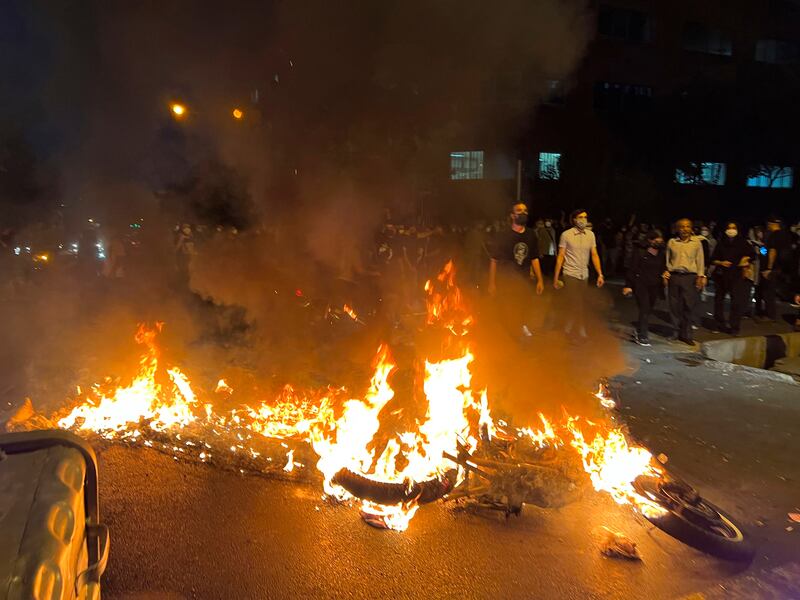Protests in Iran have spread like wildfire and former President Donald Trump’s hard-line policies may have provided the kindling.
The protests that have rocked Iran for three weeks are the largest the country has seen in over a decade, fueled by women angry over the increasingly repressive measures of the regime and a growing sense of hopelessness about the country’s economic future. Watching the unrest unfold, some have asked whether Trump’s “maximum pressure” campaign paved the way for the current anti-government uprisings.
Trita Parsi, executive vice president of the Quincy Institute for Responsible Statecraft and an expert on U.S.-Iran relations, said Trump’s implementation of harsh sanctions following his exit from the 2015 nuclear deal with Iran may have been an important factor in creating the conditions for the current protests.
“The combination of the regime’s mismanagement, repression and economic mismanagement, and on top of that sanctions that have really devastated the economy creates an explosive situation that makes protests more likely,” Parsi said.
The protests began on Sept. 16, sparked by the death of Mahsa Amini, a 22-year-old Iranian woman who had been arrested three days earlier by the country’s morality police for violating strict rules on head coverings. A photo of Amini lying unconscious in a hospital bed went viral as her family claimed she had been beaten by dress code-enforcing officials, resulting in a nationwide protest that has since spread to over 80 cities.
Like other recent protests in Iran, this has been met by a harsh response from law enforcement. There have been at least 154 confirmed deaths since the protests began, according to the Norway-based Iran Human Rights.
Even with the government’s eagerness to quell the protests, they seem to be intensifying. Dozens of videos have surfaced on social media showing large crowds confronting law enforcement officers, tearing down pictures of Supreme Leader Ayatollah Ali Khamenei, yelling “death to the dictator,” and repeating the slogan “Woman. Life. Freedom.” Most dramatically, there are videos showing women removing their mandatory headwear, the hijab, and throwing them into the flames.
Though this round of protests stands apart from others in Iran’s recent history — because of its inclusion of the middle class, clear revolutionary aspirations and focus on women — the underlying motivations are not new, according to Parsi.
“You have 40 years of repression, corruption, mismanagement by the government and a continuous depriving of the population of any hope and faith that the system can be reformed,” Parsi said.
Despite these long-standing grievances, it’s likely the current uprising was accelerated by Trump’s rejection of Obama-era foreign policy, Parsi said.
In May 2018, Trump followed through with a campaign promise to end the United States’ participation in a 2015 nuclear deal negotiated by the Obama administration. The deal was meant to limit the Iran nuclear program in exchange for relaxed U.S. sanctions. But, according to Trump, the deal was inherently flawed and “failed to protect America’s national security interests.”
Upon exiting the deal, Trump announced that previous sanctions would be reimposed on Iran and throughout the remainder of his presidency additional sanctions were levied, making it the toughest sanctions regime ever applied to the country.
In the two years following Trump’s decision, the sanctions, which levied fines on Iran’s oil exports and hundreds of individuals and companies, caused Iran’s economy to contract by almost 12%, pushing roughly 10 million people from the middle class into poverty, Parsi said, citing Hadi Kahalzadeh of Brandeis University.
According to Parsi, the failure of the Iran nuclear deal and the economic turmoil brought on by the reimposition of sanctions undermined the arguments of reformers, such as former Iran president Hassan Rouhani, 2013-2021, and paved the way for hard-liners to come to power, such as current president Ebrahim Raisi, who was elected in 2021 after the country’s Guardian Council disqualified all other serious contenders.
Since becoming president, Raisi has refused to compromise in negotiations over a revised nuclear deal and has increased enforcement of the Islamic dress code, something Raisi’s moderate predecessor had discouraged. With a failing economy and a more repressive regime in place, hope for reform has disappeared, Parsi said.
“With the manner in which the hard-liners have increasingly closed the space for change and reform from within, it is not surprising to see that people are increasingly losing confidence and faith in that it is reformable and as a result feel, rightly or wrongly, that protests and a complete overhaul of the government is the only way, the only option they have,” Parsi said.
While Trump’s policies were an important factor in creating the conditions that resulted in the current protests, they may have also decreased the chances of success, he said.
A 2012 study, co-authored by Parsi, found that almost no authoritarian regimes under broad economic sanctions have experienced a successful transition to democracy. Economic sanctions have actually helped consolidate authoritarian rule and weaken opposition, Parsi said, by making it more difficult for an impoverished population to sustain protests and by destroying the institutions and norms needed for a successful transition to democracy.
Economic sanctions against Iran remain in place under the Biden administration as negotiations over a revised nuclear deal have stalled and uncertainty over the future of the current regime continues to grow.
While it’s unlikely the regime will collapse in the near term, Parsi has no doubt that the protests will have a lasting effect. “I don’t think things can go back to the way they were.”


